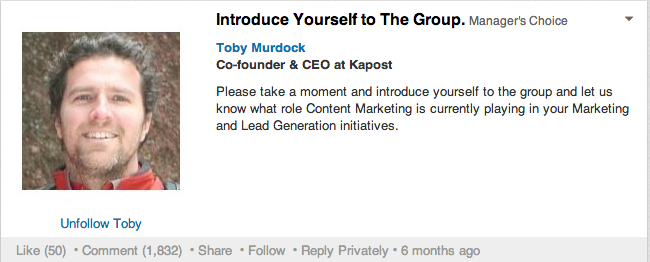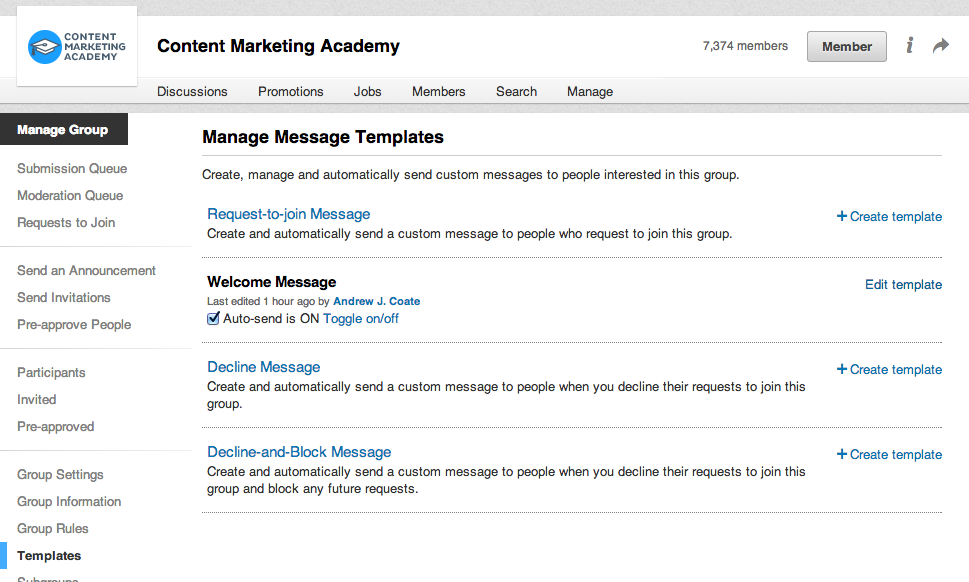How do you take a Linkedin group from 0 to 7000 members in just 6 months?
The secret to a group’s rapid growth lies in a mixture of focus, invitation, interaction, and moderation.

Okay, the secret is “MAGIC.”
Focus
You wouldn’t start a company without defining its purpose, and you wouldn’t create a piece of content without defining its goal or intended audience. Same goes for starting a LinkedIn group.
You need to understand four things: what specific topics will and will not be welcome, who will interact on those topics, what value you provide to those people, and what you expect of them in return.
Use the “Summary” and “Description” features of your LinkedIn group to clearly define your audience and intent. Click the “Manage” tab, then “Group Information” to find these.
For example, our Group Summary reads:
“The Content Marketing Academy exists for modern marketers to discuss the growing need for content. It is a spam-free space to ask tough questions and get actionable answers, and where all marketers—at every level—can learn how to use content to drive more site visitors, leads, and revenue.”
Our Group Description reads:
“Welcome to the Content Marketing Academy, the largest content marketing-focused community on LinkedIn. This is a place for marketers to discuss best practices and emerging trends, in a spam-free environment. Ask tough questions and get actionable answers, and learn how to use content to drive results and revenue. Have questions about getting started? Ask them here. Researching best practices for your next campaign? Ask the group for suggestions or examples of past successes. Curious about how others solve challenges you’re facing? Ask fellow members for advice! This group is focused on eliciting genuine dialogue and providing a safe place for questions related to content marketing. Enjoy!”
In both the versions above, a few themes show up. The group welcomes marketers of all levels, but specifically those dealing with issues around content creation as a major strategy.
We found that “spam” meant posting link after link with little to no attempt at interacting. So we banned that for the sake of community and conversation.
We also mention “spam-free.” This verbiage comes from a variety of discussions about LinkedIn group “pet-peeves.” From these conversations, we found that “spam” meant members posting link after link with little to no attempt at interacting with each other. So we banned that for the sake of community and conversation.
Having a clear idea of what your group should be, listening to its members, and declaring your mission publicly is the first large step to creating a meaningful group.
Invitation
If you’ve defined your target audience correctly, it should be pretty easy to use LinkedIn’s nifty tools to start communicating with folks. Before you write to a single person, create a template for new invitees. Connect why you’re reaching out with the value that individual will get from the group.
This takes quite a bit of manual effort, but people sincerely appreciate the time it takes to send a custom invite. It bodes well for your group if you’re relevant from the start to potential members.
Our template changes a bit based on individuals we target, but has these key elements:
- Connection (We’re in similar groups, we have similar job titles/functions/connections.)
- Invitation to join
- BRIEF description of the group’s purpose (The goal of the group is to ____.)
- Shortened link to group page
- Invitation to connect directly regardless of if they join
LinkedIn groups should not be planned with a “Field of Dreams” approach.
LinkedIn groups should not be planned with a “Field of Dreams” approach, but with an “I’m throwing a party! Now who do I invite?” approach. Sure, you want your group to grow, but as mentioned above you want the right people to join as well. Just the same as “followers” on other social sites, a LinkedIn group doesn’t succeed just because it has a lot of members, but because of who those members are. You want group members who will interact in the right ways and contribute appropriate and relevant conversations.
So, how do you find those people?
In the “Manage” tab of LinkedIn groups, you can start with relevant LinkedIn connections and invite them directly from that window, using a custom message. To invite new individuals who might be interested in the group, start with a “People” search in the search bar at the top of the page when logged into LinkedIn. I’d advise starting with the specific job title of your ideal member. Put key terms between quotation marks to further focus your search. I just did a search for “Content Marketing” and came up with this many results of people who have that exact phrase in their job title (let alone job description).

LinkedIn limits how many invites you can send out a day, so start with members you feel would bring the most value right away or would be most likely to join.
Interaction
This part is the key to your strategy. Once members join, give them an immediate reason to start chatting. Have a few discussions already started. Maybe enlist some industry friends or colleagues to jump in right away. We started with a conversation called “Introduce Yourself to the Group.” It seems simple, but at the time I’m writing this post, 1,832 people have introduced themselves—over 25% of the entire group. That’s pretty solid.

This type of discussion works because many people express anxiety about commenting on things publicly right away, and it gives them a chance to take that first leap without risking too much.
If you ask people right away to tell you who they are and what they’re interested in, you can immediately make sure your group is relevant to them.
For new members, it’s a warm and welcoming discussion. For group moderators, it’s a gold mine. If you ask people right away to tell you who they are and what they’re interested in, you can immediately make sure your group is relevant to them.
Back in the “Manage” tab of the group itself, there’s a “Templates” sub-menu that has a variety of auto-message options, including a welcome message to new people who request to join. Customize this to suit your needs. It’s valuable to monitor new group members joining and commenting on the introduction discussion, and to send them custom, private greetings to further welcome them into the fold, remind them of group guidelines, and encourage their participation.

Finally, you must interact. If you’re a member of the Content Marketing Academy, you’ve likely seen my face everywhere (you’re welcome, by the way). I don’t just start new discussions—I interact in as many ongoing conversations as possible, often pushing discussions forward with additional questions. If you want your group to be interactive, you have to be interactive. And remember. Simply posting links to your own blog posts and/or promoting your initiatives exclusively is not interactive.
Moderation
If interaction is the key to group growth, moderation is the key to sustaining that growth. Just because you have a great statement of purpose, as well as a clear set of group guidelines, doesn’t mean people will fall in line. They won’t. Well, most won’t anyway.
Our engagement rate went from under 2 comments per discussion to 13 comments per discussion.
In a recent post, How To Make Your LinkedIn Group Not Suck, I detailed our process for cutting down on spam and boosting actual discussion. The results have been amazing. We see a lot of positive sentiment about our guidelines because we addressed one of the most common complaints about LinkedIn groups. Also, our engagement rate went from under 2 comments per discussion to 13 comments per discussion.
We’ve clearly and widely publicized our guidelines and intentions. Still, we delete far more submissions than we allow—far more—because they usually don’t provide value for the group. It takes diligence, but it’s worth it, given the results. It might seem stern, but in reality you’re just sticking to your original promise. And people appreciate that.
If you’re looking for any of the above guidelines in action, join The Content Marketing Academy. Ask the group any questions you may have about why they enjoy it—or jump in with questions about content marketing. The group is ready for you.
We’ve Made it Simple
Download our Simplified Guide to Content Strategy to go from chaos to calm in your content marketing campaigns.


